Introduction
Response Rate
The study targeted 180 respondents in collecting data about comparing green facades to green roofs in a hot and humid environment. From the study, 164 out of the 180 sample respondents, filled in and returned the questionnaires making a response rate of 91%. This reasonable response rate was made a reality after the researchers made personal calls and visits to remind the respondent to fill in and return the questionnaires.
Reliability Analysis
Cronbach’s alpha was calculated by application of SPSS for reliability analysis. The value of alpha ranges from 0-1 and has indicated 0.7 to be an acceptable reliability coefficient.
The table below illustrates the results of the reliability analysis. It involved questionnaires from seven respondents. As the alpha coefficients were all greater than 0.7, a conclusion was drawn that the instruments had an acceptable reliability coefficient and were appropriate for the study.
Table: Reliability Analysis.
Validity is the accuracy or meaningfulness of inferences, which based on the research results. The validity was determined through the use of content. Validity test index which was obtained by summing items rated 3 or 4 by experts and dividing by the total number of items in the questionnaire. A content validity index of 0.802 was obtained. This value indicated that the instrument was acceptable as recommended by Davis 2002 recommended content validity index of 0.80 for new measures.
Demographic Information
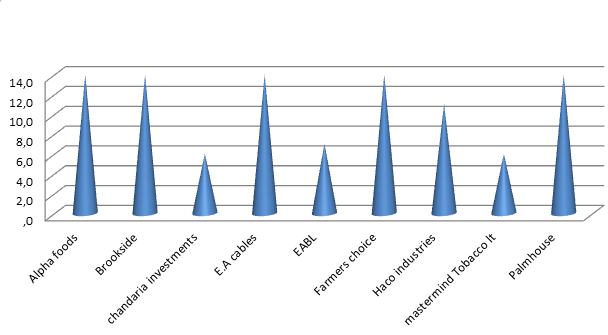
According to the findings, 14% of the respondents indicated that they had lived, currently live, maintained and installed green roofs respectively, 7% of the respondents indicated that they were specialists in green roofs and green facades, while 6% of the respondents indicated that they live and had lived in houses with green facades respectively.
Strategy
Table: The Importance of the Following Attributes On Strategy.
From the findings, the respondents indicated that developing maintenance strategy was very important when establishing a green roof and facades as indicated by a mean of 4.4. the respondents indicated that developing procurement strategy was very important in green roofs and green facades as indicated by a mean of 4.1, the respondents indicated that developing engineering strategy was important in establishing green roofs and facades as indicated by a mean of 3.9, the respondents indicated that developing inventory strategy was somewhat important in establishing green roofs and facades as indicated by a mean of 3.3.
Plan
Table: The Importance of the Following Attributes On Plan.
From the findings, the respondents indicated that performing material requirement planning and performing maintenance planning was very important in establishing green roofs and facades. As indicated by a mean of 4.2 respectively, the respondents indicated that crop (species) planning and structure planning are important when establishing green roofs and facades. As indicated by a mean of 4.0 respectively, the respondents indicated that performing inventory planning and performing operational planning was somewhat important in establishing green roofs and green facades as indicated by a mean of 3.9.

Table: The Importance of the various Attributes On Source.
From the findings, the respondents indicated that managing water source was very important in establishing green roofs and green facades as indicated by a mean of 3.9. The respondents indicated that managing plant species was very important in establishing green roofs and green facades as indicated by a mean of 3.8. The respondents indicated that performing operational procurement was important in establishing green roofs and green facades as indicated by a mean of 3.7. The respondents indicated that performing strategic sourcing was important in establishing green roofs and green facades as indicated by a mean of 3.6. The respondents indicated that managing suppliers was important in establishing green roofs and green facades as indicated by a mean of 3.5.
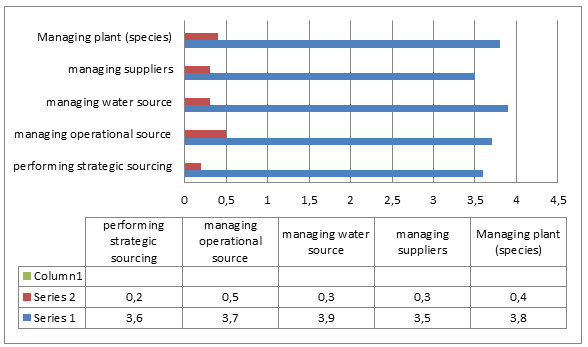
Make
Table: The Importance of the Following Attributes on Make.
From the findings, the respondents indicated that managing output quality was very important in establishing green roofs and facades as indicated by a mean of 4.1, the respondents indicated that managing material planning was very important in establishing green roofs and facades as indicated by a mean of 3.9, the respondents indicated that managing maintenance and managing output and material planning was important in establishing green roofs and facades as indicated by a mean of 3.8 respectively, the respondents indicated that managing engineering was important in establishing green roofs and facades as indicated by a mean of 3.6, the respondents indicated that managing sourcing was somewhat important in establishing green roofs and facades as indicated by a mean of 3.5.
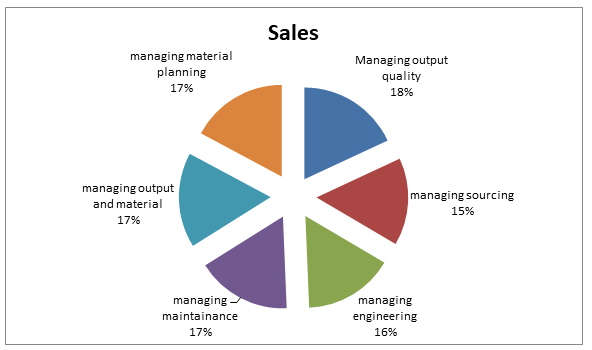
Regression Analysis
The researcher conducted a multiple regression analysis. This was done to test relationship among variables (independent) in green roofs and green facades. The statistical package for social sciences (SPSS) was applied to code, enter and compute the measurements of the multiple regressions for the study.
Table: Model Summary.
Coefficient of determination explains the extent to which changes in the dependent variable can be explained by the change in the independent variables or the percentage of variation in the dependent variable that is explained by all the five independent variables (strategy, plan, source, and make).
The five independent variables that were studied, explain only 87.4% of green roofs and green facades in hot and humid environment.as represented by the R2. This therefore, means that other factors not studied in this research contribute 12.6% factors of green roofs and green facades in hot and humid environments. Therefore, further research should be conducted to investigate the other (12.6%) factors of green roofs and facades in hot and humid environments.
Table: ANOVA (b).
- Predictors: (Constant), strategy, plan, source and make
- Dependent Variable: efficient and effective green roofs and facades.
The significance value is 0.000 which is less that 0.05 thus the model is statistically significance in predicting how strategy, plan, source, and make. The F critical at 5% level of significance was 1.74. Since F calculated is greater than the F critical (value = 7.974), this shows that the overall model was significant.
Table: Coefficients (a).
- Dependent Variable: efficient and effective green roofs and facades
The researcher conducted a multiple regression analysis so as to explaining the effects of supply chain management on overall business performance in the Kenyan manufacturing sector. And the three variables as per the SPSS generated table 4.9, the equation (Y = β0 + β1X1 + β2X2 + β3X3 + β4X4 + ε) becomes:
Y=0.574 + 0. 453X1+ 0. 666X2+ 0. 402 X3 + 0. 048 X4 + ε
Where Y is the dependent variable (efficiency and affectivity of green roofs and facades), X1 is the strategy variable, X2 is plan variable, X3 is source variable, and X4 is make variable.
According to the regression equation established, taking all factors into account (strategy, plan, source, and make) constant at zero, efficiency and affectivity of green roofs and facades was 0.574. The data findings analyzed also showed that taking all other independent variables at zero, a unit increase in strategy will lead to a 0.453 increase in efficiency and affectivity of green roofs and facades; a unit increase in the plan will lead to a 0. 666 increase in efficiency and affectivity of green roofs and facades; a unit increase in source will lead to a 0.402 increase in efficiency and affectivity of green roofs and facades; a unit increase in make will lead to a 0.048 increase in efficiency and affectivity of green roofs and facades. This infers that, the plan contributes more to overall efficiency and affectivity of green roofs and facades.
At 5% level of significance and 95% level of confidence, strategy had a 0.001 level of significance, plan showed a 0.000 level of significant, source showed a 0.003 level of significant, make showed 0.002 level of significance; hence the most significant factor is plan.
Factor Analysis
Table: Communalities.
Revision
Abstract
The study begins with exploring all aspects of building or installing a green roof and green façade onto a building. The benefits of both these green roofs and green facades are highlighted. The shortcomings of green roofs and facades are highlighted. The study of green roofs and green facades is based on their existence in a hot and humid environment.
The literature review discusses in detail, the construction process of installing a green roof and green façade into a building. The chapter also discusses the challenges encountered in installing green roofs and facades onto a building structure. Also, the benefits of green roofs and facades and their brief history are discussed.
The case study is based in Malacca, a city in Malaysia. Malacca satisfies the environment required for the study; hot and humid environment. The methodology covers the sample population of the study and various methods of data collection mainly through the administration of questionnaires to respondents.
An analysis of the data collected is carried out to extract the findings. An interpretation of the findings gives an appropriate conclusion. An appropriate design is proposed to extract sufficient remedies to the challenges extracted in the findings.
General Objective
The objective of this report is to review the various forms of green building. This is ideal for the proper understanding and adaptation of the new methods to urban housing. The research aims to find more manageable ways in terms of expenses, implementation, and creating awareness across the globe. Creating awareness will ensure involvement from members of the communities as a whole. This will eradicate, the use of unconventional building materials, and promote the adaptation of more eco-friendly building concepts.
Scope of the Work
The report looks at the various concepts introduced to cater to the green environment expected in the future. The main emphasis of the report is based on the green roofing system and the green facade. The paper covers the various kinds of green designs and their significance to the adaptation of the new environment. Another essential aspect discussed in the paper is the roofing system which is a key element in the observation of a moist environment. The paper then looks at several aspects that are required to ensure the implementation of successful green buildings and infrastructure.
Specific Objective
- Identify the comparatives of green roofs and green facades.
- The different effects of green roofs, green facades in house interior and exterior environment.
- Establish artificial equipment that is used to give the effects of the house interior environment that could be provided by green roofs and green facades.
- To establish the market perception of green facades and green roof systems.
- To establish systems innovated to improve the green facades and green roof systems.
- To establish factors hindering the widespread use of green facades and green roof systems.
- To establish how the implementation of green facades and green roof systems in hot and humid environments would differ from other environments.
Research Questions
- What artificial equipment is used to control house interior temperatures and how does compare to green roofs and green facades?
- How do green roofs and green facades compare?
- What are the innovations in the green roofs and green facades systems?
- What are the people’s perceptions of green roofs and green facades?
- How do the market’s green facades and green roofs compare to the artificial equipment used to control temperatures in houses?
- What factors are hindering the widespread use of green facades and green roofs system?
Delimitation of the Research
The research was conducted in Malaysia, South East Asia. Malaysia has an area of approximately 329847 square kilometers. It has thirteen states and three federal territories. The research focused on the state of Malacca, in its main town of Malacca. Malacca sits on land approximately 1664 square kilometers. Malacca City is the capital city of Malaysia state of Malacca
Limitation of the Study
The main limitation of the research was insufficient funds. With insufficient funds, we were unable to capitalize on new, efficient, and effective methods of research. We were able to implement methods that require average capital. The methods used were inefficient but effective and cheap. These methods include; questionnaires, electronic disks, and computers. We were able to collect, input and store research data. Sampling techniques are used to compensate for funds limitations.
Significance of the Study
This study seeks to examine all factors that are hindering the widespread use of green facades and green roofs despite their many advantages. To achieve this study, we seek the market’s perception of green roofs and green facades. The study will also seek perception on artificial products used to compensate for green roofs and facades, e.g. Air conditioners.
Data Analysis Techniques and Presentation
As mentioned in the previous section, the collection of primary data was to be performed via questionnaires. 250 Questionnaires were to be handed out to the targeted population. Since this was not feasible, an appropriate sampling method was applied for employment purposes. Through random sampling, the conclusion was that 250 questionnaires would be circulated randomly to the targeted population. Qualitative analysis analyzes the collected data. The analysis involves; proper sieving of redundant data, and modeling of quality data, capable of reaching a meaningful conclusion. We found it to be necessary that computer programs such as; excel and SPSS also be used in the analyzing process. Data representation is done using tables, pie charts, and graphs.
Percentage determines parameters in the issues of the research.
Findings
250 Questionnaires were handed out to the targeted residents. Out of the 250 questionnaires, only 200 were complete, accounting for 80% of the total respondents used as a basis of data analysis. This data was analyzed and presented to facilitate a productive completion of the study. A greater majority of the respondents were female in gender against the male gender.
Gender of the respondents in detail.
Out of the 200 questionnaires, 120 were filled by females and the 80 filled by men creating a 60:40 Ratio.
Age of the respondents.
It is necessary to note that, the government’s definition of youth as any member of the population; aged 18-35 respected in this research. Out of the 200 respondents, 30 of them aged 18-25, 60 of them aged 26-35, 70 of them aged 35-50 and 1 of them declined to disclose their age.
Number of households.
Out of the 200 respondents, 65 of them live alone, 100 of them live with 1-5 people and 45 of them live with 5 people and above.
Household Income.
Out of the 200 respondents, 90 earned between $0 – $20,000 70 earned between $20,000 – $40,000 and the other 40 earned $40,000 and above
Employment Status.
Out of the 200 respondents, 70 employed, 80 unemployed, and 50 were self employed.
Occupation.
In occupation section, considers only the 80 respondents, of the total 200 respondents who unemployed. Out of 80 of the unemployed, 40 were students, 20 were in various training facilities, and the other 20 were in other occupations.
Residence water source.
Out of the 200 respondents, 110 relied on government source of water, 70 on manmade source of water and 200 on natural sources of water.
Roof Types.
Out of the 200 respondents, 50 lived in houses with flat concrete roof tops 80 lived in houses with parallel sheets roof top and 70 lived in Block apartments hence they shared one roof.
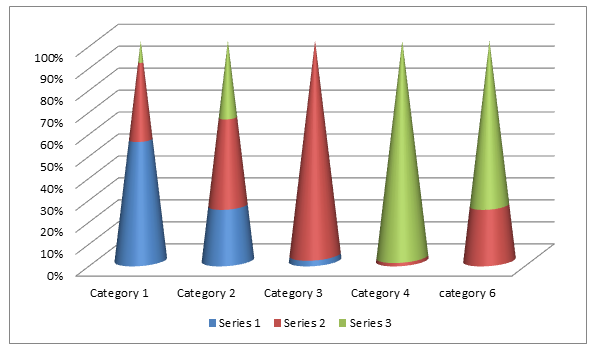
- Category1:Series1; represents the number of 55% of respondents that depend on government source of water. Series2; represents the 35% of respondents that depend on manmade water sources. Series3; represents the number 10% of respondents who depend on natural water sources.
- Category2: Series 1; represents the 25% of respondents that live in houses in houses with flat concrete roof tops. Series2; represents the 40% of respondents who live in houses with roof sheets. Series3, represents the35% who live in block houses, and have-no independent roof space.
- Category3:Series1; represents the 2.5% of respondents with houses with green roofs. Series2 represents 97.5% of respondents with houses without green roofs.
- Category4:Series2; represents 1.5% of respondents with houses without green facades.Series3; Represents 98.5% of houses with green facades.
- Category6, Series2, represents 25% of respondents of houses with air conditioner. Series3, represents 75% houses without air conditioners.
Occupants of Green Houses.
Out of the 200 respondents, 8 were living in green houses, 192 were not living in Green housing. It is essential to note that, according to this research, Green houses considered as, any house using a solar panel, any house with a green roof, and any house with green walls.
Occupants of houses with Green Roofs.
Out of the 200 respondents, 5 were occupants of houses with Green roofs while 195 of the other respondents were non occupants.
Occupants of Houses with Green Facades.
Out of the200 respondents, 3 lived in houses with facades , and the other 197 were non occupants of houses with facades.
Occupants of houses with Air conditioner.
Out of the 200 respondents, only 250 live in houses with air conditioners, the other 175 live in houses without air conditioners.
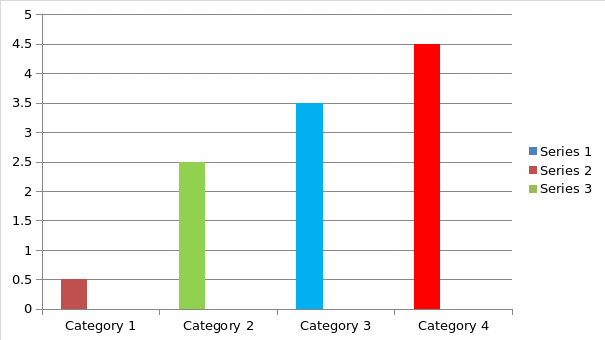
- Category 1: represents the respondents who felt no need for green roofs and facades.
- Category 2: Represents the respondents who prefer the green facades.
- Category3: Represents the respondents who prefer the green roof.
- Category4: Represents the respondents who prefer both green roofs and green facades.
Results

The age of the participants were divided into five groups. As table 4.3 shows, majority of the sample (26.3%) were of the opinion that it was very expensive’ to install and maintain green roofs and facades, followed by 22.7% who were of the opinion that it was expensive’ to install and maintain green roofs and facades.12% dint know and only 4.2% were of the opinion that green facades and roofs are affordable to install and maintain.
Proposed Design
This system consists of several Zigbee wireless sensors that are used for automation processes. Nowadays they are used in home automation system, because they run on low power and usually work for more than 2 years, without the need for replacing the battery and most importantly the price is cheap. They can be programmed by electronic engineers in microcontroller for smart home systems. Water meter indicate the level of water in the tank and lines. If the gauge of the tank water meter is upper than normal, emergency valve open the line to the urban sewage system. Otherwise, according to the regular basis the pump will be turned on by automation control system and water will pass through another filtration step to remove waste materials.
The green roof also contains a Leak detection layer, this are leak detection systems embedded into the waterproof membrane layer. This system locates any leaks in the root area for easy repairs (Christian Werthmann 12)
In the drainage system, there is a filter layer. The filter layer consists of a geotextile fabric placed between the drainage layer and the growing medium. (Newman 54) The purpose of this layer is for solid particles from the growing medium from interfering or clogging up of the drainage system. A water storage system can be added in the system, to collect the water drained for irrigation recycling. The storage system should be accessed by plant roots. (Otto-Zimmermann 18) Materials such as hydrocele should be used since they have properties to absorb water as well as oxygen to be released when required (Zack 111).
Although applying fertilizer is not necessary in every day and it is applied on regular monthly or yearly basis, this system considers a section for injecting liquid fertilizers to the water. Main line is divided to three sections, one goes to the roof and two others will feed the green façades. The plants will be irrigated by drip irrigation system. Each one of three water lines is connected to solenoid valve that is controlled by wireless sensor switch and get functions from control system. Another of the key factors of minimizing maintenance required is getting the substrate right. A low nutrient, free draining substrate, is going to cause much less of a weed problem compared to a highly organic and nutrient rich material (0tto Zimmerman 83).

Figure 4.1 shows the 3D view of the building. The excess water is coming down through the drainage pipe of roof and façade. In the other side filtered water is pumped and stored for irrigation process.
Figure 4.2 shows the entire storage and pumping mechanisms including first step filtration, storage in the tank and pump. The pump is connected to the electrical outlet because usually pumps need more power and batteries cannot supply required power. However, hot and humid environments have high winds; a simple wind vane can be used to power the pump. Solar power is another viable option source for power. These are the two cheapest sources of electric power.


Figure 4.3 the shows liquid fertilizer injection system and water is moved upward to reach top of the building. Backflow prevention is very necessary for the system since the dirty materials can affect the filtration equipment and water. Contaminated water can harm the plants and destroy the green roof and green façade. Top view of the green roof structure with drip irrigation system is plotted in Figure 3.4.

For efficiency and managing of water resources, drip irrigation system is chosen to irrigate the plants. Drip irrigation systems usually work under lower water pressure and this can reduce the numbers of switching pump on and off totally reduce the cost of energy. This method eliminates, the many man hours that could have been invested in irrigating the green roof and facades (Bowe 67).
Cross section view of the building and one side of green façade are shown in Figures 4.5 and 4.6 respectively.
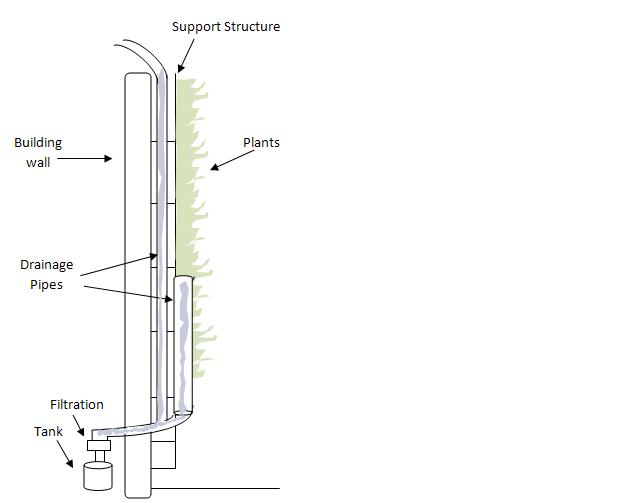
As it is shown in Figures 4.5, the roof drainage pipe is behind the support structure and green facade drainage pipes are in front of façade but after collecting water these two pipes contact with each other behind the structure. They will fall to the filtration equipment in the building.
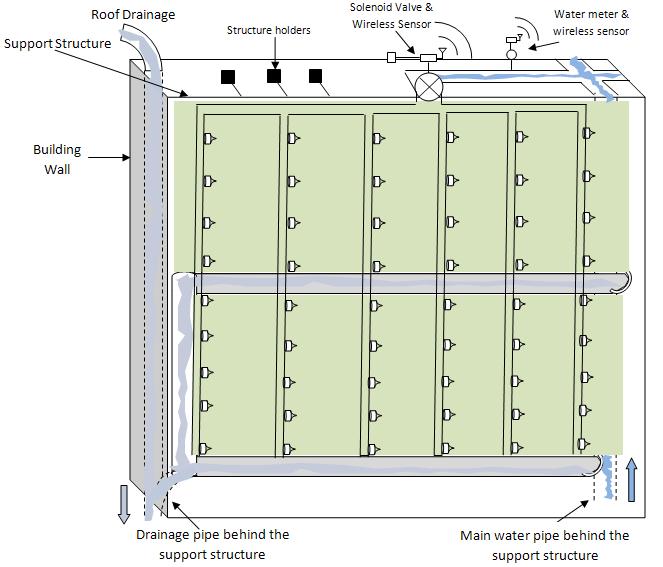
As it is shown in Figure 4.6, the main water lines are behind the support structure. Water meter indicates the pressure of water and report it to control system. If the pressure is under the threshold level control system send command to the pump and turn it to fill the lines with water.
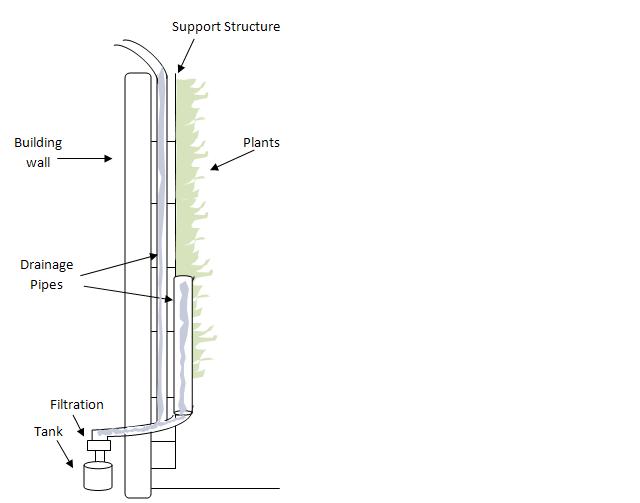
As it is shown in figures 4.7 the roof drainage pipe is behind the support structure and green facade drainage pipes are in front of façade but after collecting water these two pipes contact with each other behind the structure. They will fall to the filtration equipment in the building.
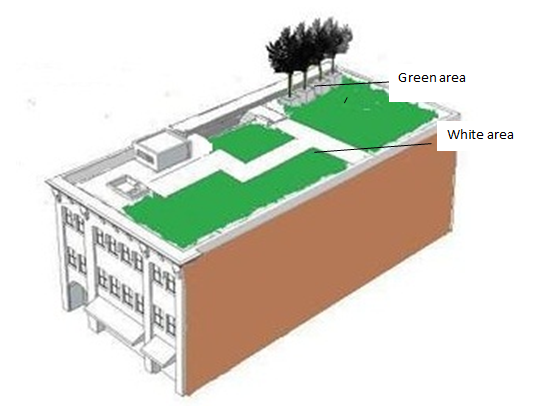
Important note
Facades Hybrid system is used, this method involves, placing the growing container in front of the building spandrel panel. This provides shade to the spandrel and allows light into the building. This system allows light into the system and reflects heat. It can be used on even multi story buildings (Newman 51).
The green areas represent areas where the green box is installed. Plants can vary from; plant: Tomato ‘Tiny Tim’ Leeks, orach (purple), spinach, pak choi , rainbow chard, stevia , jubaea chilensis, and marigold e.tc. When food production is preferred.
Apart from wind exposure, temperatures of the environment must be considered because most plants start to become stressed at around 33celcius, and start to shut down at 40celcius to maintain their survival. It is necessary to note; the average temperature for Malacca is approximately 30.1°C with a deviation of about ±2.7°C that is from 8 am–5 pm while the average temperature at night is 28.1°C ± 1.7°C (Bueren 101). This means that most species would qualify in this area.
There are a number of plants species occurring in the natural environment and also in the harsh built environments (Brebbia & Beriatos 2011). These plants can adapt to and exist to a living wall. For instance, plant species that naturally grows on cliff tops and the face of cliffs can be naturally suitable. This is because a cliff face interacts with the wind in the same way as a building facade. In the built environment, plants exposed to wind buffering from human activities such as passing vehicles (Foley 56). The traditional way as suggested earlier of living walls was to plant self supporting creepers. The species most commonly used especially in the temperate climate were Ivy (hedera helix), Boston ivy and Virginia creeper (Hopkins 171). However, this method had limitations as most of these creepers only grew 10m-20m on average (Gary 83).
Virginia creeper is the most preferred as it does not damage the wall substrate in its process of supporting itself, as opposed to ivy, which does. Virginia creeper uses minute sanction caps to secure the plant structure to the wall, which is typically Brick or masonry (Jakle 46). Screen reclassified as green facade system. It uses natural characteristic of climbing plants to provide vegetation (Lucket 56).
Findings
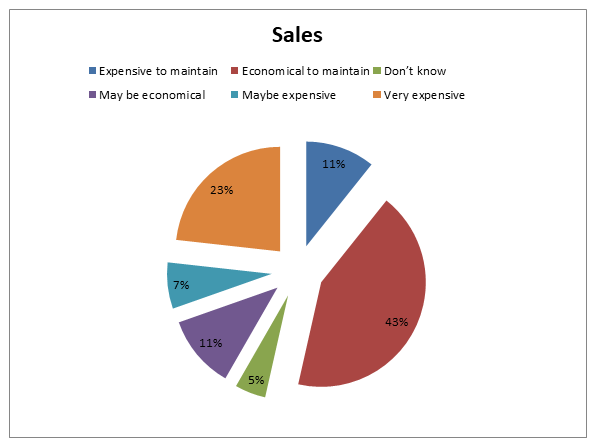
Effectivity
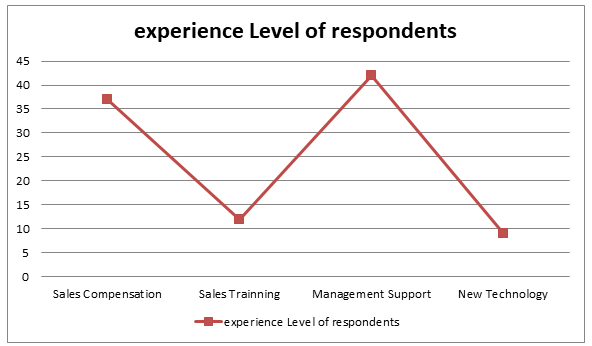
Conclusion and Recommendations
This chapter discusses the conclusions and recommendations of the study based on the objectives of the study. The objective of this study was to investigate comparatives concerning green roofs and facades as stated by the topic and specified in chapter 1.
Conclusion
The respondents conveyed common misconception and factual knowledge on green facade and green roof. Most respondents are against green facades, on the misconception that the plants hook themselves on the wall of the house, making the house walls weaker. Another concern was that one would need to use a lot of energy to pump water up to the plant. The irrigation quantity also seems to be a lot of water, another extra expense. In general, the perception was that green facades require a lot of maintenance which require a lot of effort and expenses (Carmeliet 38).
Most respondents were not able to differentiate green facades from green walls. Green wall systems are constructed from modular pre vegetated or vegetated mat walls that fixed to a wall. Green walls tend to require maintenance. I.e. Frequent irrigation and addition of fertilizer, than green facades planted into the ground (Carl 25).
Green facade is a living wall system where plants or cascading ground covers supported on specially designed structures (Beaver 100). The plants may be planted in the ground or elevated containers. There are several methods of protecting the wall from damage (Cotrell 57). Choose the right species, in choosing the plant to use in the facade; one should consider the environment.
Respondents were concerned since, the plants absorption is affected by the wind and air movement. In areas where the wind is in high velocities (Malacca included), this becomes a serious problem since this dries the leaves and the roots of the plants. In this situation, even if water made available to the roots, the evaporation rate is too high hence; type loss of water via the leaves and plant cannot much to the rate of absorption at the roots (Snodgrass 102).
According to the respondent’s perceptions, they are more conversant with ivy plant, which used to wreck walls in its self support process. Also, Respondents had the perception that green facades obstruct sunlight from entering the building by blocking windows and other sunlight access (Luckett 2009).
Respondents displayed concerns that collection of rain water would be hindered by the green facade. On the contrary, even with a green facade, rain water can be harvested and stored for reuse. The water can be cleaned through bio filtration systems for reuse (Dunnett 61). When the green facade planted in the ground, the vegetation requires similar water requirements to a ground garden bed of similar size. However, if the green facade system planted in an elevated planting container, the water supply would be similar to any containerized planting bed with a drip or subsoil irrigation system (O’Carroll 10).
The respondent’s opinion was that green roofs are heavy especially after the soil absorbs rainfall water. Most respondents feared that, the weight might cause the roof to collapse into the building. Most respondents also claimed that, during wet seasons, it would be difficult to identify where leaks were and also difficult and expensive to repair. Most respondents claimed that green roofs were expensive to build. In the findings, we discussed that most of the respondents who preferred green roofs; live in houses with flat concrete tops, employed and above average house hold income (Van Bueren et al 2011).
In general, as discussed in the literature review, green roofs are more expensive to build than ordinary roofs (Thorpe 170). Advocates of green roofs cite the potentially longer lifespan of green roof as a justification for the extra expense (Venhaus181). It is also necessary to note, that green roofs add value to the building. Given that property value accumulates, this value accumulates with the green roof value addition. This considered, people should look at green roofs as a future investment (Werthmann 71). This is because the expenditure invested on the green roof considered and accumulated over the periods alongside the property value (Woodroof 53).
Nowadays, there are various systems recommended for implementation into the green roof. These systems made to prevent most of the respondent’s fears. The water proof membrane, placed over the structural roofing system, to make the roof water proof. This membrane ensures there are no leaks in the roof (Yudelson 32). Root protection barrier, this often incorporated in the water membrane as a chemical barrier (Snodgrass 41). A physical barrier is also commonly used such as geotextile fabric. (O’Carroll 32).
Other respondents claimed that a lot of energy would be use in pumping water up the roof to irrigate the green roof. Others also claimed the green roof would make rain water collection impossible (Jari & Breuste 2011). Drainage layer, proper drainage is essential in a green roof to avoid over saturation of water in the growing medium and provide roots with ventilation. The perception that green roofs require ongoing maintenance can be a difficult and inaccessible situation to most people (Newman 54). These prospects by themselves may put people off from having a green roof. In reality, the amount of maintenance required might be relatively slight or almost non existent.
Recommendations
The proposed design employs most of these remedies to evade the above challenges. The feedback from the market showed an appreciation of these methods as a result of the markets perception towards the proposed design.
The use of Virginia creepers can be used to cut cost, the plant is natural climbing plant and hence would not need the many structures that make green facade expensive. It also requires minimum maintenance (Girard 76). These species satisfies all characteristic of species used in green facades; fast growing, foliage from ground to top, resistance to wind buffering, orientation to full sun exposure and partial shadowing during the days from nearby buildings (Magali 83).
Trellis is a series of wires or cables attached to a structure. The structure attached to the building envelope or can be free standing. This structure allows the climbing plant to grow up the wall without any direct contact with the wall. This ensures that the wall is safe and not weakened by the plants growth (Bauer 96). Modular Trellis panel system, this is a rigid, light weight, three dimensional panels made from welded steel that supports plants both on the face rigid as well as the panel depth. This structure designed to keep the green facade off the wall surface so that the plant material cannot attach to the building (Chew 23).
Cable and wire, cable used for supporting fast growing plants, whereas wire used to support slow growing plants. All of the above methods recommended in growing green facades, while avoiding damage of the building wall (Michelin 67).
As observed, green facades do not need a lot of water they do not hinder water collection, and there are even methods that can be recommended to save water and general costs of irrigation (Cottrell 2011). To save water a recycle of waste water recommended, this involves using drip trays to collect the excess water draining through the system. This waste water then recycled back into the irrigation system to be re used. It is beneficial to note that this system would require a waste pipe into the system (Otto 53).
The user does not even have to have a water source. As discussed earlier, storm water can be harvested and stored and cleaned through a bio filtration strip, to make it suitable for reuse in a living wall system. It is possible to store this water in the public or private realm under the pavement or landscape areas (Santamouris 95). The water can be stored within the living wall system. Storage of water where it is to be used is the most efficient use of energy. This goes to show that green facades can be run on natural source of water, and little energy needed to maintain the green facade (Weiler 26).
Recommendation for further studies
This study has investigated the comparatives between green roofs and green facades in hot and humid environments. The study has also managed to gather findings on the market perceptions and challenges faced by green roofs and facades. These challenges and perceptions are the main cause of lack of green roofs and green facades widespread use.
Moreover, the quantitative study carried out revealed some of the most crucial factors that should be observed in relation with eradicating these challenges in green roofs and green facades. To this end, a study should be carried out to find out how practical, efficient and effective these factors are in eradicating the challenges in green roofs and facades.
Moreover, further studies should be performed to reveal more challenges and remedies in the green roof and green facades.
Works Cited
Beaver, Robyn. Green School Primer Lessons in Sustainability. USA: Images Publishing, 2009. Print.
Bowe, Alice. High-Impact, Low-Carbon Gardening. 1001 Ways to Garden Sustainably. Ohio: Timber Press, 2011. Print.
Brebbia, Carl, and Elias Beriatos. Sustainable Development and Planning V. Barbados: WIT Press, 2011. Print.
Bauer, Michael, and Michael Schwarz. Green Building: Guidebook for Sustainable Architecture. Germany: Springer, 2009. Print.
Bueren, Ellen, and Hein Van Bohemen. Sustainable Urban Environments: An Ecosystem Approach. Chicago: Springer, 2011. Print.
Carmeliet, Jan et al. Research in Building Physics: Proceedings of the 2nd International Conference on Building Physics. Belgium: Taylor & Francis, 2003. Print.
Chew, Michael, and Tan Phay Ping. Staining of Facades. France: World Scientific, 2003. Print.
Cottrell, Michelle. Guidebook to the Leed Certification Process: For Leed for New Construction, Leed for Core & Shell, and Leed for Commercial Interiors. New Zealand: John Wiley & Sons, 2011. Print.
Dunnett, Nigel, and Noël Kingsbury. Planting green roofs and living walls. California: Timber Press, 2008. Print.
Foley, Georgina. Houses of Steel: Living Steel’s International Architecture Competitions. Chicago: Images Publishing, 2010. Print.
Gary, Grant. Green Roofs and Façades. Illinois: IHS BRE Press, 2006. Print.
Girard, Luigi, and Tüzin Baycan and Peter Nijkamp. Sustainable City and Creativity: Promoting Creative Urban Initiatives. CHICAGO: Ashgate Publishing, Ltd., 2012. Print.
Hopkins, Graeme, and Christine Goodwin. Living Architecture: Green Roofs and Walls. Csiro Publishing, 2011. Print.
Jari, Niemelä and Jürgen Breuste, Urban Ecology: Patterns, Processes, and applications. Oxford: Oxford University Press, 2011. Print.
Jakle, John, and Douglas K. Meye. Common Houses in America’s Small Towns: The Atlantic Seaboard to the Mississippi Valley. Georgia: University of Georgia Press, 1989. Print.
Luckett, Kelly. Green Roof Construction and Maintenance. USA: McGraw-Hill Prof Med/Tech, 2009. Print.
Magali, Bodart and Arnaud Evrard. Plea 2011: Architecture & Sustainable Development. France: Presses Univ. de Louvain, 2011. Print.
Michelin. Michelin Green Guide Tuscany. Tuscany: MICHELIN, 2010. Print.
Newman, Julie. Green Education: An A-To-Z Guide. USA: SAGE, 2011. Print.
O’Carroll, Oda, and David Atkinson. Corsica. France: Lonely Plane, 2004. Print.
Otto-Zimmermann and Konrad. Resilient Cities: Cities and Adaptation to Climate Change – Proceedings of the Global Forum 2010. Germany: Springer, 2011. Print.
Santamouris, Mat. Advances in Building Energy Research. North london: Earthscan, 2009. Print.
Snodgrass, Edmund, and Linda McIntyre. The Green Roof Manual: A Professional Guide to Design, Installation, and Maintenance. Timber Press, 2010. Print.
Thorpe, David. Sustainable Home Refurbishment: The Earthscan Expert Guide to Retrofitting Homes for Efficiency. Texas: Earthscan, 2010. Print.
Van Bueren Ermin et al. Sustainable Urban Environments. New York: John Wiley and Sons, 2011. Print.
Venhaus, Heather L. Designing the Sustainable Site: Integrated Design Strategies for Small Scale Sites and Residential Landscapes. Australia: John Wiley & Sons, 2012. Print.
Weiler, Susan, and Katrin Scholz-Barth. Green Roof Systems: A Guide to the Planning, Design, and Construction of Landscapes Over Structure. New York: John Wiley and Sons, 2011. Print.
Werthmann, Christian. American Society of Landscape Architects. Green Roof: A Case Study. Princeton Architectural Press, 2007. Print.
Woodroof, Eric A. Green Facilities Handbook: Simple & Profitable Strategies for Managers. U.S.A: The Fairmont Press, Inc, 2009. Print.
Yudelson, Jerry. Green Building Trends: Europe. Minnesota: Island Press, 2009. Print.
Zack, Darwin. Green Designs; Australia: john Wiley & Sons, 2012. Print.
Appendix
Questionnaire
Respondent profile
- Name
- Gender
- Age
- What is the number of your household?
- What is your household income?
- ($0-$20,000)
- ($20,000-$40,000)
- ($40,000-$Above)
- Employment status
- (Employed)
- (Training)
- (Student)
- (Others)
- Occupation
- Which is your source of water?
- (Government source)
- (Manmade source)
- (Natural source)
- Which below is your roof type?
- (Flat concrete top)
- (Sheets roof top)
- (No roof (Block apartments)
- Do you live in a house with Green Roof?
- (Yes)
- (No)
- Do you live in a house with Green Facades?
- (Yes)
- (No)
- Do you live in a house with an Air Conditioner?
- (Yes)
- (No)
Please, tick where necessary (Answer only one criteria)
Please, read the proposed designed below and answer the following question appropriately
Proposed Design
This system consists of several Zigbee wireless sensors that are used for automation processes. Nowadays they are used in home automation system, because they run on low power and usually work for more than 2 years, without the need for replacing the battery and most importantly the price is cheap. They can be programmed by electronic engineers in microcontroller for smart home systems. Water meter indicate the level of water in the tank and lines. If the gauge of the tank water meter is upper than normal, emergency valve open the line to the urban sewage system. Otherwise, according to the regular basis the pump will be turned on by automation control system and water will pass through another filtration step to remove waste materials.
The green roof also contains a Leak detection layer, this are leak detection systems embedded into the waterproof membrane layer. This system locates any leaks in the root area for easy repairs (Christian Werthmann 12)
In the drainage system, there is a filter layer. The filter layer consists of a geotextile fabric placed between the drainage layer and the growing medium. (Newman 54) The purpose of this layer is for solid particles from the growing medium from interfering or clogging up of the drainage system. A water storage system can be added in the system, to collect the water drained for irrigation recycling. The storage system should be accessed by plant roots. (Otto-Zimmermann 18) Materials such as hydrocele should be used since they have properties to absorb water as well as oxygen to be released when required (Zack 111).
Although applying fertilizer is not necessary in every day and it is applied on regular monthly or yearly basis, this system considers a section for injecting liquid fertilizers to the water. Main line is divided to three sections, one goes to the roof and two others will feed the green façades. The plants will be irrigated by drip irrigation system. Each one of three water lines is connected to solenoid valve that is controlled by wireless sensor switch and get functions from control system. Another of the key factors of minimizing maintenance required is getting the substrate right. A low nutrient, free draining substrate, is going to cause much less of a weed problem compared to a highly organic and nutrient rich material (0tto Zimmerman 83).
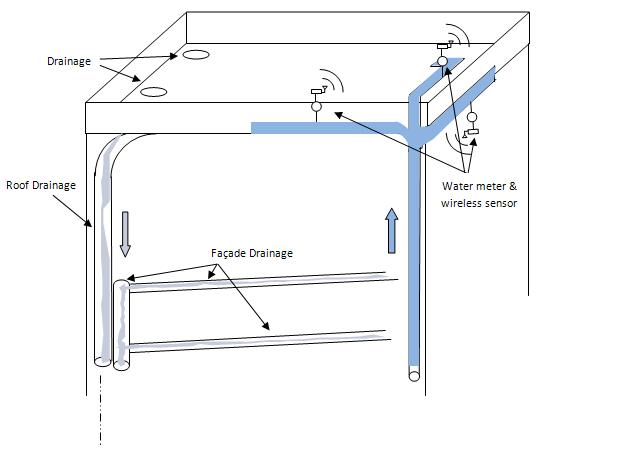
Figure 4.1 shows the 3D view of the building. The excess water is coming down through the drainage pipe of roof and façade. In the other side filtered water is pumped and stored for irrigation process.
Figure 4.2 shows the entire storage and pumping mechanisms including first step filtration, storage in the tank and pump. The pump is connected to the electrical outlet because usually pumps need more power and batteries cannot supply required power. However, hot and humid environments have high winds; a simple wind vane can be used to power the pump. Solar power is another viable option source for power. These are the two cheapest sources of electric power.
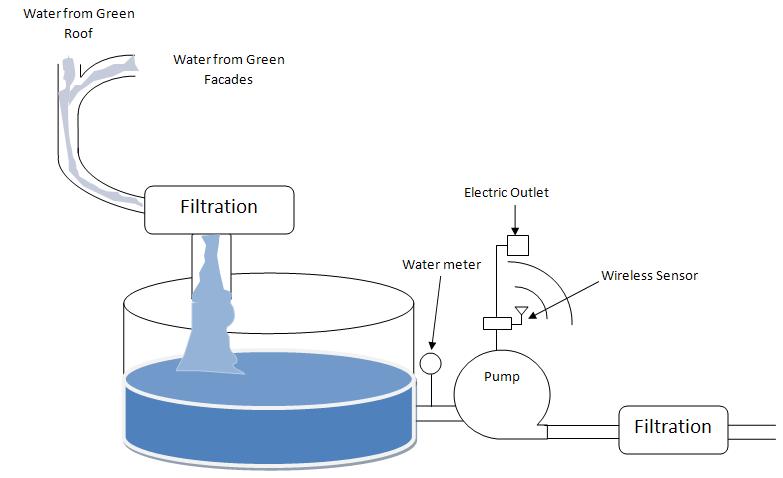
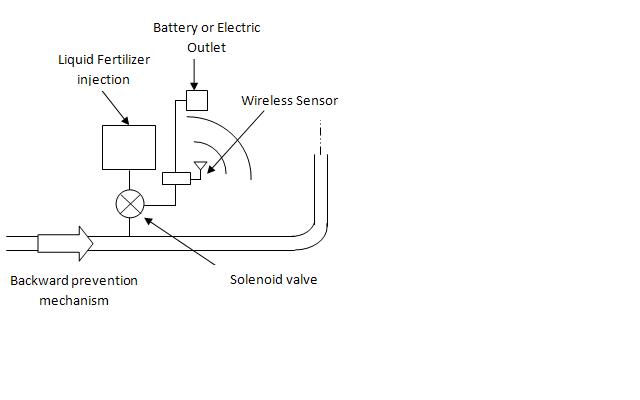
Figure 4.3 the shows liquid fertilizer injection system and water is moved upward to reach top of the building. Backflow prevention is very necessary for the system since the dirty materials can affect the filtration equipment and water. Contaminated water can harm the plants and destroy the green roof and green façade. Top view of the green roof structure with drip irrigation system is plotted in Figure 3.4
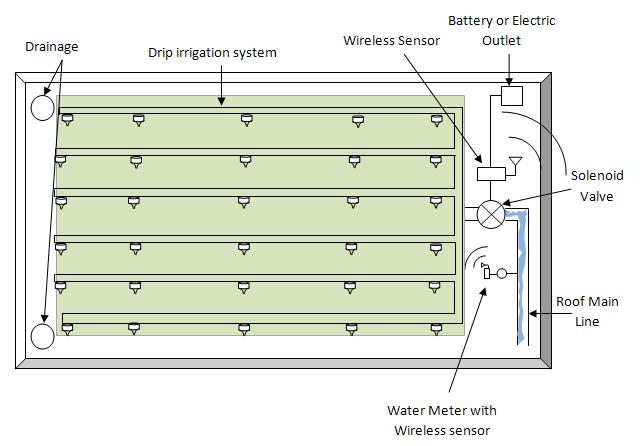
For efficiency and managing of water resources, drip irrigation system is chosen to irrigate the plants. Drip irrigation systems usually work under lower water pressure and this can reduce the numbers of switching pump on and off totally reduce the cost of energy. This method eliminates, the many man hours that could have been invested in irrigating the green roof and facades.
Cross section view of the building and one side of green façade are shown in Figures 4.5 and 4.6 respectively.
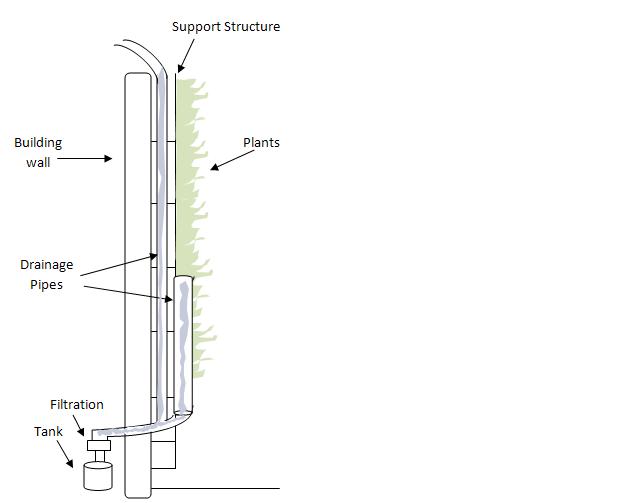
As it is shown in Figures 4.5, the roof drainage pipe is behind the support structure and green facade drainage pipes are in front of façade but after collecting water these two pipes contact with each other behind the structure. They will fall to the filtration equipment in the building.
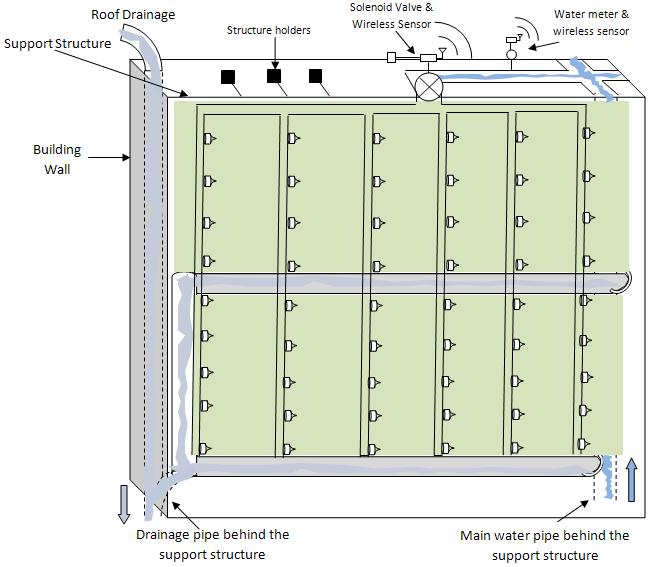
As it is shown in Figure 4.6, the main water lines are behind the support structure. Water meter indicates the pressure of water and report it to control system. If the pressure is under the threshold level control system send command to the pump and turn it to fill the lines with water.

As it is shown in figures 4.7 the roof drainage pipe is behind the support structure and green facade drainage pipes are in front of façade but after collecting water these two pipes contact with each other behind the structure. They will fall to the filtration equipment in the building.

Important note
Facades Hybrid system is used, this method involves, placing the growing container in front of the building spandrel panel. This provides shade to the spandrel and allows light into the building. This system allows light into the system and reflects heat. It can be used on even multi story buildings (Newman 51).
The green areas represent areas where the green box is installed. Plants can vary from; plant: Tomato ‘Tiny Tim’ Leeks, orach (purple), spinach, pak choi , rainbow chard, stevia , jubaea chilensis, and marigold e.tc. Where food production is preferred.
Apart from wind exposure, temperatures of the environment must be considered because most plants start to become stressed at around 33celcius, and start to shut down at 40celcius to maintain their survival. It is necessary to note; the average temperature for Malacca is approximately 30.1°C with a deviation of about ±2.7°C that is from 8 am–5 pm while the average temperature at night is 28.1°C ± 1.7°C (Bueren 101). This means that most species would qualify in this area.
There are a number of plants species occurring in the natural environment and also in the harsh built environments. These plants can adapt to and exist to a living wall. For instance, plant species that naturally grows on cliff tops and the face of cliffs can be naturally suitable. This is because a cliff face interacts with the wind in the same way as a building facade. In the built environment, plants exposed to wind buffering from human activities such as passing vehicles (Foley 56). The traditional way as suggested earlier of living walls was to plant self supporting creepers. The species most commonly used especially in the temperate climate were Ivy (hedera helix), Boston ivy and Virginia creeper. (Hopkins 171). However, this method had limitations as most of these creepers only grew 10m-20m on average (Gary 83).
Virginia creeper is the most preferred as it does not damage the wall substrate in its process of supporting itself, as opposed to ivy, which does. Virginia creeper uses minute sanction caps to secure the plant structure to the wall, which is typically Brick or masonry (Jakle 46). Screen reclassified as green facade system. It uses natural characteristic of climbing plants to provide vegetation (Lucket 56).
Please choose appropriately (Only choose 1 criteria)